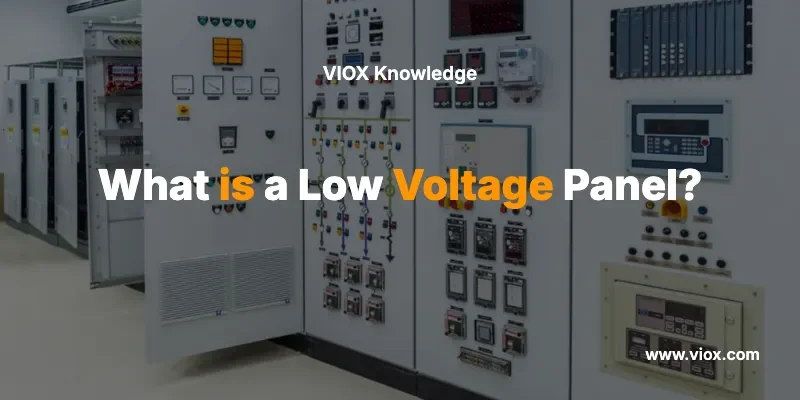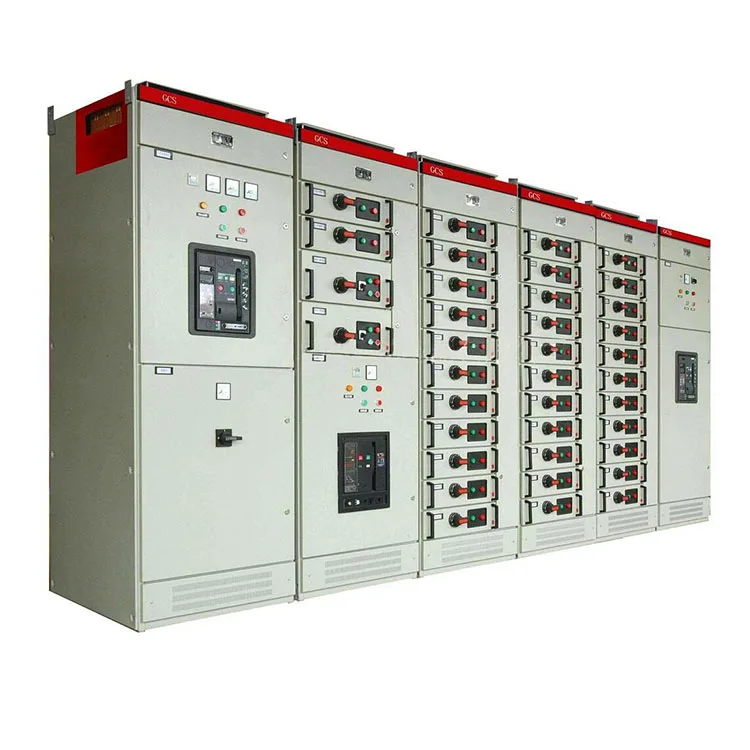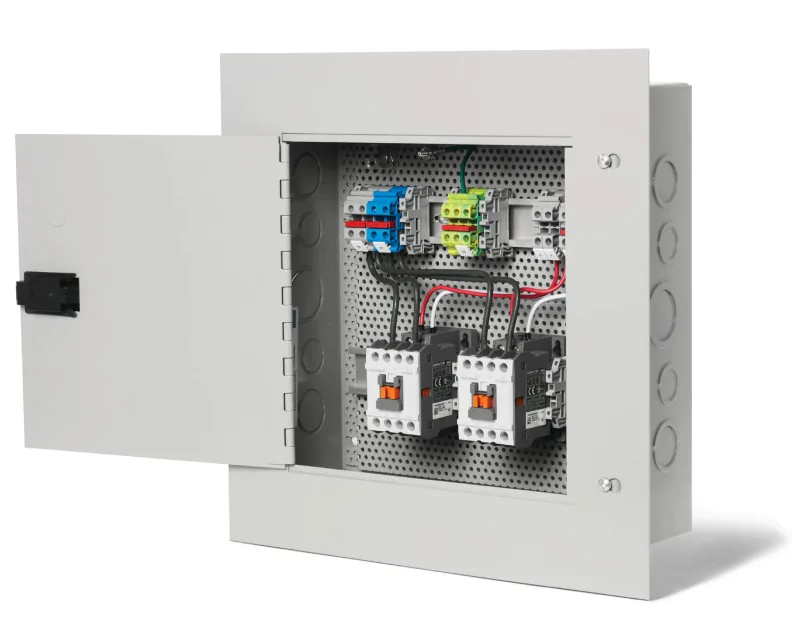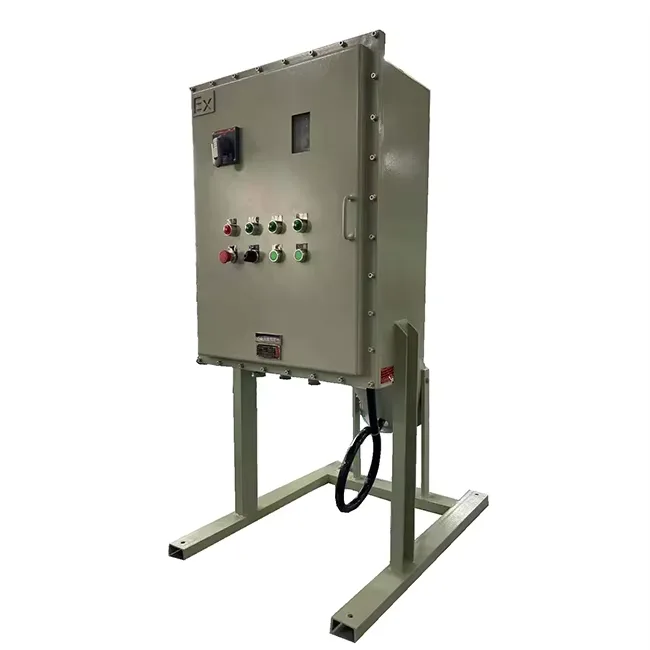Ein low-voltage-panel ein elektrischer Verteiler, verwaltet und verteilt die elektrische Energie in der Regel bei Spannungen unter 1000 Volt AC oder 1500 Volt DC. Diese Platten dienen als zentrale Kontroll-Punkte, die sicher verteilen Strom aus main power Quellen zu verschiedenen schaltungen, Lasten und Geräten in Wohn -, Gewerbe-und Industrieanlagen.
Low-voltage-panels sind die grundlegenden Sicherheits-Komponenten, zu schützen elektrische Systeme durch Leistungsschalter, sicherungen und überwachung-Geräte und bietet organisierte power distribution lighting, outlets, HLK-Systeme, und andere elektrische Geräte.
Was Macht Low Voltage Panels, Verschiedene von High Voltage Module?
Das Verständnis der Unterscheidung zwischen Niedervolt-und Hochvolt-panels ist von entscheidender Bedeutung für die elektrische Sicherheit und die richtige system design.
Low-Voltage-vs-High-Voltage-Panel-Vergleich
| Feature | Low Voltage Panels | High Voltage Panels |
|---|---|---|
| Spannungsbereich | Unter 1.000 V AC / 1.500 V DC | Über 1.000 V AC / 1.500 V DC |
| Typische Anwendungen | Residential, small commercial, control Systeme | Industrieanlagen, utility Unterstationen |
| Sicherheitsanforderungen | Standard-Elektro-Sicherheitstechnik | Spezielle Hochspannungs-Sicherheits-Protokolle |
| Komplexität der Installation | Moderate qualifizierten Elektriker | Hoch – spezialisierten Technikern erforderlich |
| Kosten | Niedrigere initial-und Wartungs-Kosten | Höhere initial-und Wartungs-Kosten |
| Platzbedarf | Kompakte, Wand-montiert oder Boden-stehend | Größere Aufstandsfläche, spezielle Zimmer |
| Arc Flash Gefahr | Niedriger Energie Ebenen | Höhere Energie Ebenen, spezielle PSA erforderlich |
Schlüssel-Komponenten der Niederspannungs-Panels
Low-voltage-Module enthalten mehrere wichtige Komponenten, die zusammenarbeiten, um einen sicheren und zuverlässigen Energieverteilung:
Wesentliche Panel-Komponenten
1. Hauptsicherung oder der Hauptschalter
– Steuert die Stromversorgung der gesamten panel
– Bietet Notfall-Ausschaltung
– Größe nach panel gesamten Stromstärke Bewertung
2. Branch Stromkreisunterbrecher
– Schutz der einzelnen Stromkreise aus überstrom
– Erhältlich in verschiedenen Stromstärke Bewertungen (15A, 20A, 30A, etc.)
– Fahrt automatisch, wenn die Schaltung überlast Auftritt
3. Bus Bars
– Kupfer oder Aluminium Leiter, verteilen power
– Main-bus trägt Sie die macht von service-Eingang
– Ast-Busse verteilen power zu einzelnen schaltungen
4. Neutral-und Boden-Bars
– Bieten Rückkehr Pfad für elektrischen Strom
– Wichtig für die Sicherheit und ordnungsgemäße Schaltung Betrieb
– Muss richtig verklebt pro NEC-Anforderungen
5. Panel-Gehäuse
– Schützt die internen Komponenten vor Umwelteinflüssen
– Bietet Sicherheit Schutz gegen elektrischen Kontakt
– Erhältlich in verschiedenen NEMA-Kenndaten, die für verschiedene Umgebungen
🔧 Experten-Tipp: Stellen Sie immer sicher, dass Ihre low-voltage-panel erfüllt die entsprechenden NEMA Bewertung für die installation Umgebung. Indoor-panels verwenden in der Regel NEMA 1, bei outdoor-Installationen erfordern NEMA 3R oder höher Bewertungen.
Arten und Klassifizierungen von Low Voltage Panels
Low voltage panels sind in verschiedenen Konfigurationen für spezifische Anwendungen und Anforderungen an die installation.
Panel-Typen, die durch Anwendung
| Paneltyp | Spannungsbereich | Typische Verwendung | Wesentliche Merkmale |
|---|---|---|---|
| Wohn-Lastzentren | 120/240V single-phase | Wohnungen, kleine Wohnungen | 20-40 schaltungen, Stecker-in Leistungsschalter |
| Kommerzielle Faserplatten | 120 V/208 V oder 277/480 V drei-phase | Bürogebäude, Bauten des Einzelhandels | 30-84 schaltungen, bolt-on BREAKER |
| Industrielle Schalttafeln | 24V-600V DC/AC | Fertigung, automation | Benutzerdefinierte Konfigurationen, monitoring-Systeme |
| Motor Control Center (MCC) | 208-V-600 V drei-phase | Industrie-Motoren | Variable frequency drives, starter |
| Distribution Panels | 120V-600V | Große Einrichtungen | Hohe Stromstärken, mehrere Feeder |
Panel Klassifikationen von Bau -
Surface-Mounted Panels
– Installiert auf Wand Oberflächen
– Einfacher Zugang für die Wartung
– In kommerziellen Anwendungen
Flush-Mounted (Recessed) Panels
– Installiert in Wand Hohlräume
– Sauberer Aussehen, platzsparend
– Beliebt im Wohn-Installationen
Free-Standing Panels
– Floor-mounted units
– Höhere Kapazität Anwendungen
– Industrie und große gewerbliche Nutzung
Anwendungen und Anwendungsfälle für Low Voltage Panels
Low-voltage-Paneele dienen vielfältige Anwendungen in Wohn, kommerziellen und industriellen Sektoren.
Anwendungen für Wohnzwecke
Primäre Funktionen:
– Distribute power from utility service zu Hause schaltungen
– Schützen Sie Beleuchtung und Steckdose schaltungen
– Steuern Sie Haushaltsgeräte (Warmwasserbereiter, HVAC, etc.)
– Bieten GFCI-und AFCI Schutz durch code erforderlich
Gemeinsame Wohn-Paneel-Größen:
– 100-amp-service: Kleinere Häuser, grundlegende elektrische Anforderungen
– 200-Ampere-service: Standard-moderne Häuser
– 400-Ampere-service: Große Häuser und Wohnungen mit umfangreicher elektrischer Systeme
Kommerzielle Anwendungen
Bürogebäude:
– Power distribution Etagen und Mieter Räume,
– Lighting control systems
– HLK-Ausrüstung macht
– Notfall Beleuchtung-schaltungen
Einzelhandelseinrichtungen:
– Speichern Sie die Beleuchtung und display power
– Point-of-sale-system-Stromkreise
– Sicherheit power system
– Kältetechnik schaltungen
Industrielle Anwendungen
Produktionsstätten:
– Motor control and power distribution
– Prozess control system power
– Sicherheit-system-Stromkreise
– Instrumentierung und überwachung Ausrüstung
Rechenzentren:
– Server-rack-Stromverteilung
– USV-system integration
– Environmental control power
– Netzwerk Geräte schaltungen
⚠️ Sicherheit Warnung: All low-voltage-panel-Installationen entsprechen müssen National Electrical Code (NEC), Artikel 408 und örtlichen elektrischen codes. Nur von qualifizierten, lizenzierten Elektriker durchführen sollten-panel-Installationen oder Modifikationen.
Wie Wählen Sie die Richtige Low-Voltage-Panel
Die Wahl des geeigneten low-voltage-panel erfordert eine sorgfältige Berücksichtigung von mehreren kritischen Faktoren.
Auswahlkriterien-Checkliste
1. Elektrische Beanspruchung
– Berechnen Sie die Gesamt-Anschlusswert in Ampere
– Berücksichtigen Sie zukünftige Erweiterungen anpassen (hinzufügen von 25-30% Kapazität)
– Bestimmen Sie die Spannung und phase-Anforderungen
– Beurteilen short-circuit current ratings
2. Umgebungsbedingungen
– Indoor-vs. outdoor-installation
– Temperatur und Luftfeuchtigkeit überlegungen
– Korrosiven Atmosphäre Anforderungen
– Seismic and vibration Faktoren
3. Code Compliance-Anforderungen
– NEC-Artikel 408 (Schaltanlagen-und Faserplatten)
– Die lokalen elektrische code-änderungen
– UL 67 (Faserplatten) - Zertifizierung
– NEMA Einhaltung von standards
4. Der Physische Raum Einschränkungen
– Platzverhältnisse
– Arbeitszeiten Freiräume (NEC 110.26)
– Montage Konfiguration Einstellungen
– Zukünftige Zugänglichkeit muss
- Panel Sizing Guide
| Anwendung | Empfohlene Stromstärke | Typische Schaltkreisanzahl |
|---|---|---|
| Kleine Residenz | 100-150A | 20-30 schaltungen |
| Standard-Home - | 200A | 30-40 schaltungen |
| Großes Haus | 300-400A | 40-60 schaltungen |
| Kleine, Kommerzielle | 225-400A | 30-50 schaltungen |
| Den Großen Kommerziellen | 600-1200A | 50-84 schaltungen |
🔧 Experten-Tipp: Immer Größe-panels für 80% Ihrer Nenn-Kapazität, um eine ausreichende Wärmeableitung und code-compliance. Ein 200-Ampere-panel sollte nicht überschreiten 160 a der angeschlossenen Last.
Installation und Sicherheitshinweise
Die ordnungsgemäße installation von Niedervolt-Platten ist entscheidend für die Sicherheit, compliance code und zuverlässigen Betrieb.
Voraussetzungen vor der Installation
1. Design und Genehmigungen
– Holen Sie sich die notwendigen elektrischen erlaubt
– Vollständige load-Berechnungen und panel-Zeitpläne
– Verify-Dienstprogramm service-Anforderungen
– Plan für die gewünschten arbeiten Freigaben
2. Vorbereitung Des Standorts
– Sorgen Sie für eine angemessene strukturelle Unterstützung
– Überprüfen der Umgebungsbedingungen
– Plans cable routing und Zugriff
– Koordinieren mit anderen Gebäude-Systeme
Installation Safety Requirements
Anforderungen für Arbeitsräume (NEC 110.26):
– Front: Mindestens 3 Meter klarer Arbeitsraum
– Breite: Panel Breite oder 30 cm minimum, je nachdem, welcher größer ist
– Höhe: 6.5 Meter vom Boden oder der Plattform
– Ein Separater Raum: Bereich oberhalb panel zu strukturellen Decke
Erdung und Bonding-Anforderungen:
– Main bonding jumper-installation
– Schutzleiter-verbindungen
– Neutral und Boden-Trennung (für einzelflächen)
– Grounding electrode conductor sizing
⚠️ Kritischer Sicherheitshinweis: Versuchen Sie niemals, zu installieren, zu verändern, oder service-low-voltage-Panel ohne ordnungsgemäße elektrische Ausbildung und Lizenz. Elektrische Arbeit stellt eine ernsthafte Risiken der Schock, Stromschlag, Feuer und Tod.
Wartung und Fehlersuche
Die regelmäßige Wartung gewährleistet den sicheren und zuverlässigen low-voltage-panel-Betrieb, während die Verlängerung der Lebensdauer der Ausrüstung.
Routinemäßiger Wartungsplan
Monatliche Inspektionen:
– Sichtprüfung auf Anzeichen von überhitzung
– Überprüfen Sie auf lose verbindungen oder beschädigte Bauteile
– Überprüfen Sie, ob Tür-Verschluss und Schloss Betrieb
– Dokument eine ungewöhnliche Bedingungen
Jährliche Professionelle Wartung:
– Thermografische Prüfung von verbindungen
– Drehmoment-überprüfung aller verbindungen
– Isolierung Widerstand Test
– Arc-flash-hazard assessment update
Häufige Probleme und Lösungen
| Problem | Mögliche Ursachen | Professionelle Lösungen |
|---|---|---|
| Häufige Circuit Breaker Trips | Überlastete Stromkreise, fehlerhafte Ausrüstung | Last analysis, circuit Rekonfiguration |
| Panel Überhitzung | Lose verbindungen, überlastung | Verbindung festziehen, Last Umverteilung |
| Spannungsschwankungen | Utility-Probleme, schlechte verbindungen | Utility Koordination, Verbindung, Reparatur |
| Korrosion/Oxidation | Umweltexposition | Austausch von Komponenten, Gehäuse upgrade |
🔧 Experten-Tipp: Zeitplan jährliche thermografische Inspektionen zu identifizieren, hot spots, bevor Sie zu Sicherheit Gefahren. Lose verbindungen erstellen können gefährlich arc flash Bedingungen.
Code Compliance und Standards
Low voltage panels entsprechen müssen zahlreiche Normen und standards zu gewährleisten die Sicherheit und den ordnungsgemäßen Betrieb.
Schlüssel-Code-Anforderungen
National Electrical Code (NEC) Artikel:
– Artikel 408: Schalttafeln und Faserplatten
– Artikel 110: Anforderungen für Elektrische Installationen
– Artikel 240: Überstromschutz
– Artikel 250: Erdung und Bonding
Industrielle Normen:
– UL 67: Standard-Faserplatten
– UL 891: Schaltanlagen-Norm
– NEMA PB 1: Faserplatten-Standards
– IEEE-Standards: Installation und testen von Anforderungen
Anforderungen Für Die Zertifizierung
Panel Zertifizierungen:
– UL-gelistete Komponenten und Baugruppen
– CSA-Zertifizierung für Kanadische Anlagen
– NRTL (Nationally Recognized Testing Laboratory) - Zulassung
– Local authority having jurisdiction (AHJ) Genehmigung
Häufig Gestellte Fragen
Was ist der Unterschied zwischen einem Faserplatten und einer Telefonzentrale?
Schalttafeln sind in der Regel für maximal 1.200 Ampere ausgelegt und verwenden steckbare oder anschraubbare Leistungsschalter. Schalttafeln sind für mehr als 1.200 Ampere ausgelegt und verwenden einzeln montierte, stationäre Schalter und Leistungsschalter in einer kundenspezifischen Baugruppe.
Wie oft sollten Niederspannungstafeln überprüft werden?
Sichtprüfungen sollten monatlich und umfassende professionelle Inspektionen jährlich durchgeführt werden. Bei stark beanspruchten Industriepaneelen kann eine häufigere Wartung (alle 6 Monate) erforderlich sein.
Kann ich einem vorhandenen Niederspannungspanel Stromkreise hinzufügen?
Ja, sofern das Panel über ausreichend Platz und Kapazität verfügt. Diese Arbeiten müssen jedoch von einem zugelassenen Elektriker durchgeführt werden und erfordern in der Regel eine Elektrogenehmigung und -prüfung.
Was führt zum Ausfall eines Niederspannungspanels?
Zu den häufigsten Ursachen zählen lose Verbindungen, die zu Hitzestaus führen, Überstrombedingungen, Umweltfaktoren wie Feuchtigkeit oder Korrosion sowie altersbedingte Verschlechterung der Komponenten.
Woher weiß ich, ob mein Niederspannungspanel ausgetauscht werden muss?
Anzeichen hierfür sind häufiges Auslösen des Leistungsschalters, sichtbare Korrosion oder Schäden, über 25–30 Jahre alte Paneele, unzureichende Kapazität für die Stromlast oder Paneele, die nicht den aktuellen Sicherheitsvorschriften entsprechen.
Wie hoch ist die typische Lebensdauer eines Niederspannungspanels?
Gut gewartete Module halten in der Regel 25–40 Jahre. Module in rauen Umgebungen oder bei starker Beanspruchung müssen jedoch möglicherweise früher ausgetauscht werden.
Benötigen Niederspannungsschaltanlagen für die Wartung Spezialwerkzeuge?
Ja, für eine ordnungsgemäße Wartung sind Infrarotthermometer, Drehmomentschlüssel, Isolationsprüfer und geeignete persönliche Schutzausrüstung (PSA) für Elektroarbeiten erforderlich.
Kann das Wetter die Leistung von Niederspannungspanels beeinträchtigen?
Ja, extreme Temperaturen, Luftfeuchtigkeit und Nässe können die Leistung der Module beeinträchtigen. Für den Außenbereich geeignete Module erfordern entsprechende NEMA-Bewertungen und benötigen möglicherweise zusätzlichen Umweltschutz.
Quick Reference Guide
Checkliste zur Panelauswahl
- Berechnen Sie den gesamten elektrischen Lastbedarf
- Ermitteln Sie den Spannungs- und Phasenbedarf
- Überprüfen Sie den verfügbaren Installationsspeicherplatz
- Umgebungsbedingungen prüfen
- Bestätigen Sie die Anforderungen zur Code-Konformität
- Planen Sie für zukünftigen Erweiterungsbedarf
- Einholen der erforderlichen Genehmigungen und Zulassungen
Sicherheitshinweise
- Schalten Sie vor Arbeiten am Panel immer die Stromversorgung aus
- Verwenden Sie bei Elektroarbeiten geeignete PSA
- Halten Sie die erforderlichen Arbeitsabstände ein
- Testen Sie die Schaltkreise, bevor Sie mit der Arbeit beginnen
- Befolgen Sie die Lockout/Tagout-Verfahren
- Lassen Sie Arbeiten nur von Elektrofachkräften durchführen
Notfallmaßnahmen
- Elektrischer Notfall: Hauptschalter sofort ausschalten
- Feuer: Verwenden Sie nur Feuerlöscher der Klasse C
- Elektrischer Schlag: Rufen Sie 911 an und berühren Sie das Opfer nicht, bis der Strom abgeschaltet ist.
- Lichtbogenblitz: Umgebung räumen, Notdienst anrufen
Related
Was führt dazu, dass Solarmodule Feuer fangen? Ein umfassender Sicherheitsleitfaden
Wo befindet sich der Verteilerkasten und wie findet man ihn?





